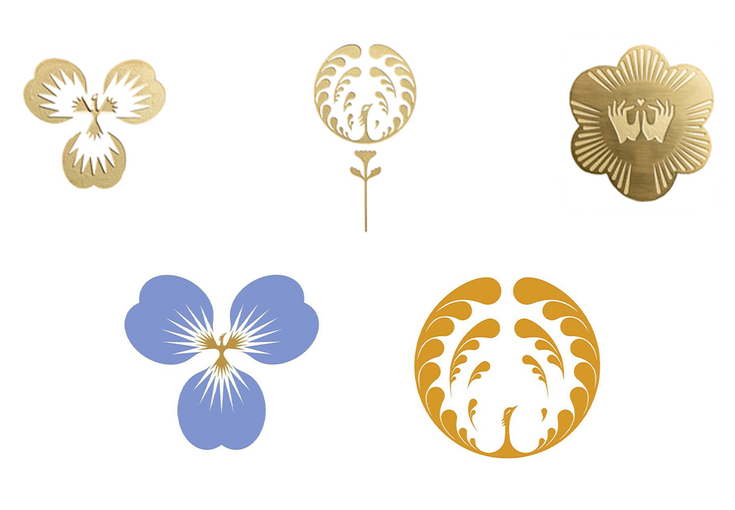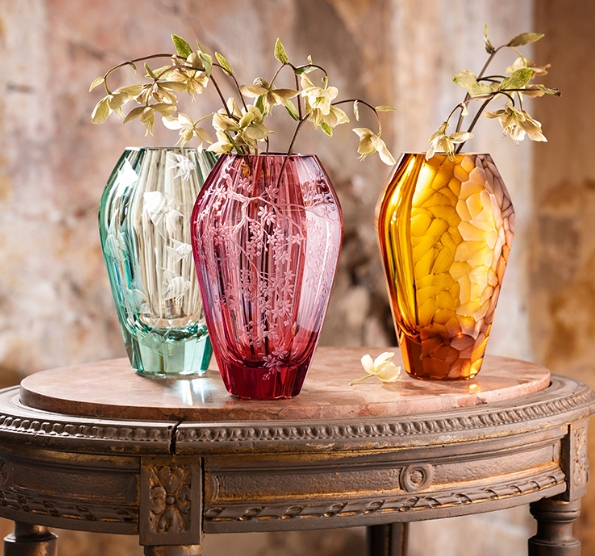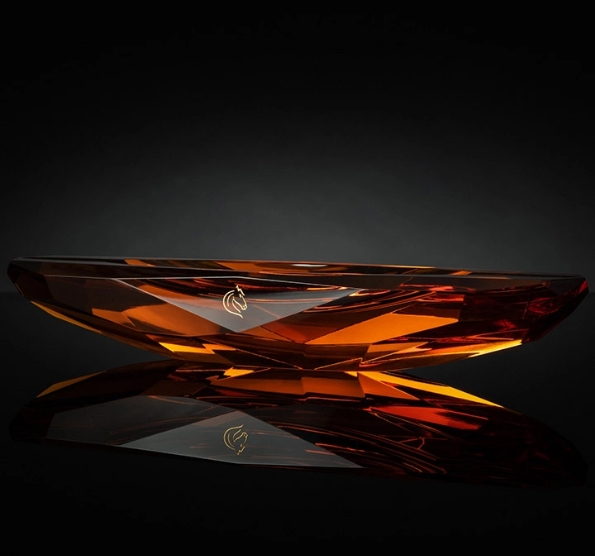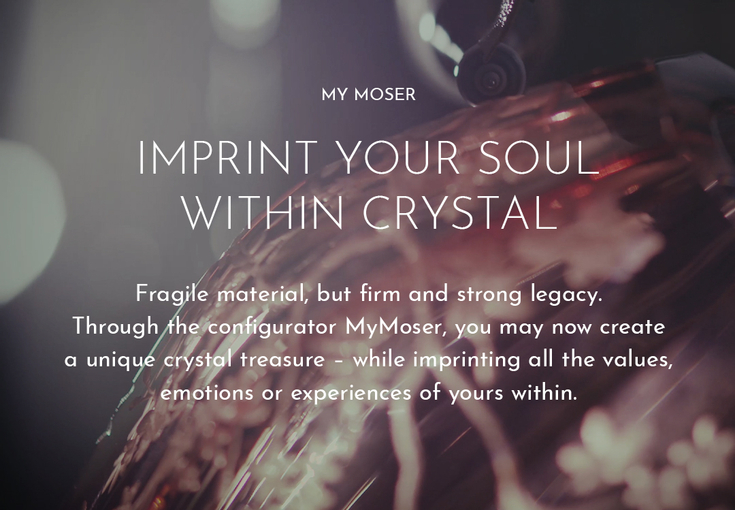Breadcrumbs navigation
- Home page
- About Moser
- Blog
- Gold colour refers to heaven and looks nobly on glass, as the illustrator Maria Makeeva claims

Gold colour refers to heaven and looks nobly on glass, as the illustrator Maria Makeeva claims
While her authorship abounds with mythological motifs, she can illustrate almost anything. An artist Maria Makeeva has been working with golden serigraphy for rather a long time. Now some of her motifs can be transferred to crystal through the configurator MyMoser. Why had Maria opted for a motif of the mythical phoenix? What does glass arouse within her?
You work mainly with paper and serigraphy. How do you perceive glass?
It fascinates me. It is almost hypnotic and full of contrasts – material but clear and pure. Massive and heavy but so fragile. It comes from the earth – but comes through fire and takes up a form of water. It reminds me of alchemy. As if there was a touch of magic within the art of glassmaking. Not to mention how flexible glass is – what shapes and forms it can take.
Have you been working with glass before?
I’ve never designed a motif to be applied to glass. Although, I’ve peeped inside the environment of glass society before. It was when I prepared illustrations for a company called Lasvit – illustrations referring to the history of glassmaking. But this was rather a different kind of experience. So, when Moser approached me with crystal designs in February, I was very pleased, indeed. To be precise, it evoked a mixture of happiness, pride, gratitude and restlessness within me – that kind of feeling one feels when working on something they’d never done before.
Your illustrations are pure and modern, while Moser stands for tradition, realistic patterns and very gentle details. Was it hard to connect those two approaches?
I’ve been given the opportunity to bring modernity into such a time-proven and precise handicraft. In my view, following up with such a deep tradition and legacy would mean a challenge to any illustrator. Therefore, we carefully considered the motifs – thinking about which would be distinguishable even on the smaller scale, as we needed to make our motifs several times smaller.

The mythical phoenix*, having a double graphic depiction, remains the main symbol. Why such a motif?
The motif of phoenix is inspired by the year 2020 – the year of the pandemic origins. Phoenix means a symbol of rebirth from within our own ashes. I regarded this as a very poetic and allegoric expression of all those events and emotions we experienced. Initially, the motif meant a dose of support to our closest relatives. The motif of phoenix has strength and depth within. And it is flexible enough. Moreover, its bright gold colour matches the visual language of Moser. From the very beginning, I knew my phoenix had the potential to be portrayed within glass.
One of your designs resembles a pansy with this mythical creature in its centre. It seems to be an intentional connection of Moser’s Art Nouveau style, together with your innovative approach towards graphic illustration.
This was not the intention, in fact. But it all came nicely together – in terms of both shape and colour. The petals were light blue in the original serigraphic version. Although, through the method of sandblasting, they turned out milk-white on glass. And such a colour goes well with gold.
The motif of hands and heart you’ve included within your collection – what’s the symbolism?
I created this one for a purpose of wedding greetings cards. I wanted the motif to give the impression of being festive and flexible, too, so it could be applied to a different occasion if required. This motif holds love, tenderness and care within – feelings you wish to express to someone. Also, it remains part of my collection to enliven those motifs of flowers and birds.
Mythology as a source of inspiration
How is it that mythical themes catch your attention so much? Is there a culture you get inspired by the most?
It had all started with my thesis at UMPRUM – where I engaged in serigraphic pages of large format. My work was inspired by Slavic mythology, which somehow required working with gold colour. Also, my interest in universal symbolism had increased by then. I realized that many symbols I came across were not of Slavic, Greek, Celtic nor Mayan origins – but that they were mostly universal. It was probably those we’ve had inscribed within our collective unconscious. Such archetypes very much attract me – and remain my inspiration up to this day.
Have you been exploring how were such symbols depicted across various cultures?
Though I care about such a depiction, it remains a very complex theme. It is always about the technique – some symbols were worked out through engravings, some through statues and others through embroidery. There exists plenty of such symbols within mythology – and all remain bound to the culture. I try to take the heart of such symbols and depict it again – so it looks timeless. That’s what I like about it. However, it is not quite possible, as there is still this subjective perception of mine. But I make efforts to depict those symbols in a more universal and simple way.
What’s the role of the gold colour?
In the case of serigraphy, each colour is printed separately. That’s why I aimed to reduce the number of colours within my thesis. Moreover, mythology often works with the dualism of light-dark and earth-heaven. Eventually, I opted for two colours – gold, symbolizing heaven and sun and black, embodying the earth and substance. Additionally, I worked with a red colour. This meant life, blood and metamorphosis. With the gold colour, I first hesitated which shade to apply – if to stick with a hint of gold and use deep yellow, or to choose a more distinct, metallic shade of gold colour.

Based on what were you deciding?
First of all, I hesitated because of the cliché I held within me – that gold means kitsch and may give the impression of being in bad taste. While working on my research, I realized it was not the case. In terms of early Renaissance paintings, hand-decorated medieval books or glasses with an adorable technique of oroplastic – gold colour is noble in any case. And so, I agreed on trying it. Since then, I just cannot stop.
In the case of serigraphy, the gold colour’s quality and design depend on the printer. But here you must rely on the craftsman from the painter’s workshop, as they cannot make a single mistake.
Yes, that’s right. And by the way, that’s also one of the reasons why I could’ve never been a glassmaker. As an illustrator, I need to know I can always take a step back and rearrange something if needed. But in Moser’s workshops, every single step matters– and not only in the case of glass’ casting or blowing. It’s a difficult job. Plus there’s very little space for mistakes. That’s why I have such respect for all craftsmen working for Moser.
Do you own anything from Moser?
One glass is already on its way. I am so excited about it. We once presented my cousin with a couple of Moser glasses as a wedding gift. But I’ve never owned anything myself. Realizing the very first piece would be designed by me was a beautiful feeling.
START DESIGNING
Maria Makeeva
We visited this young illustrator at Charaktery Design Store in Letná, Prague. In here, you may come across not only large-format pieces of serigraphy, but also little greetings cards of her own brand Maria Makeeva Ateliér. Maria graduated from the field of illustration and graphics at UMPRUM, Prague. She’s already managed to collaborate with the National Institute of Mental Health and the National Gallery. You may surely recognize this unmistakable handwriting of hers – be it within a book, greetings or payment card.

*Throughout which cultures had appeared the image of phoenix?
A mysterious creature of ancient Egypt, or a famed being immortalized by a Roman poet Ovid. Ancient Egyptians used to worship the heron Benu – the original deity, being born from within itself when the Earth emerged from the immemorial waters. As a symbol of rebirth and immortality, this image was being imprinted on ancient amulets. Such a symbol was related to the flooding periods of the river Nile – as the Nile meant wealth and fertility.
A Greek historian Herodotos placed a legend of a bird upon record – a bird living for 500 years, building and setting its own funeral pyre on fire. So “from within the father’s body a young phoenix would be born, phoenix living for as long as his father did,” as Ovid wrote in Metamorphoses. Phoenix had found its place in Asia, too – where it means a sovereign of all birds and symbolizes the beginning of the new era. Furthermore, the natives of American land used to call it the Thunderbird. In Russia and other Slavic countries, this figure appears in a fairytale called O Ptáku Ohniváku. And eventually, the figure of phoenix had caught the attention of Czech writer Karel Jaromír Erben.










